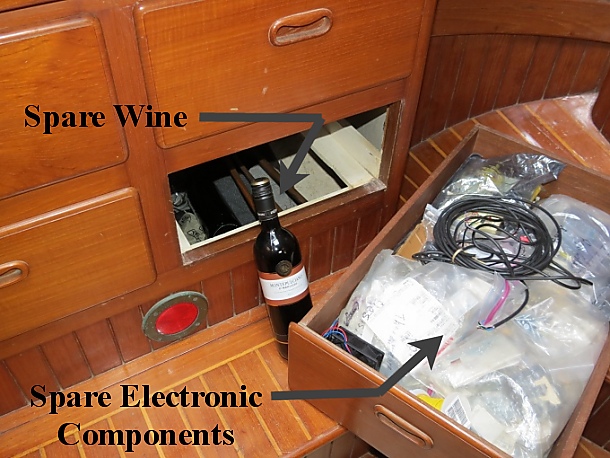The Blue View - Where's the Spares?
/A few days ago I wrote a blog about my philosophy on how many spares are enough. Basically, my feeling is you can never have too many spares. The trick is finding a place to stow them and then finding them again in a year or so when you need them. One thing we often do when storing a spare that probably won't be used for awhile is bag it in plastic using a vacuum sealer. This keeps it protected and rust free indefinitely. If there is any doubt as to what the part is, I write the part's name or its use clearly on a piece of paper and put it inside the bag. We bought a food vacuum bagging machine a few years ago with the intention of using it to repackage bulk purchases of staples like rice and flour. We still use it for this, but also discovered how useful it is for parts storage. The bags can be purchased in various sizes or in roll form, and we can vacuum bag just about any size part.
It would be nice if I could just assign some cubby or storage area as the “Engine Spares Stowage Area” for example and put all my engine spares there, but it never seems to work out well if I try to do this. I have large engine spares, like heat exchangers, starter motors and exhaust manifolds that aren't needed often. These fit nicely under the aft bunk along with a couple of spare anchors, a spare hydraulic ram and an emergency fuel bladder. The smaller spares, like solenoids, belts, and thermostats fit nicely under the nav station seat, while all my spare hoses and fittings fit under the forward sink. My engine gaskets have to be kept flat, so they reside under the forward bunk, and the consumables, like filters and engine anodes live behind the starboard settee. Multiply this by 40 for all the other systems and spares, and distribute them in the 50 or so small cubbies and storage areas aboard, and it gets complicated remembering where everything is.
So a few years ago I worked out a system of sorts. I assigned a three character alphanumeric code to every storage area on Nine of Cups. The first character is a letter that defines the area of the boat. For example, the letter 'A' means the aft cabin, 'G' would indicate the galley and so on. The second character indicates which quadrant in the area it is located; 'S' for starboard, 'P' for port, 'A' for aft and 'F' for forward. The third character is a number that indicates which storage area in the quadrant the part is located. So, AS2 would be the designator for the second locker on the starboard side of the aft cabin. I used my label maker to create labels that I attached to the inside of each storage locker as well. Finally, each part that is listed in my Little Black Book has this three digit notation added to it.
This sort of works and I can find the spare I'm looking for about 75% of the time. The remaining 25% of the time, I forgot to enter the part in my LBB, forgot to write the location of the part down or moved the part after I wrote its location down. So 25% of the time I end up spending between five minutes and two days tearing the boat apart, looking for a particular part.
I was reading the latest issue of Good Old Boat, and noticed a product announcement for a new iPhone App called What's on my boat that tracks all those spares – where they're stowed and how many. Could be just the thing; but I suspect I'd still have to remember to enter the part, quantity and location into the database, then have the discipline to keep it up to date as I used a spare, bought more, or changed the location.
I remember reading an article about how couples become more like each other the longer they live together. When we first started dating almost 30 years ago, Marcie was almost compulsively organized, while I was more on the slob side of the spectrum. Now, I like to think I am a lot more organized and a whole lot neater, while Marcie is nowhere near as compulsive. At this rate, in another 20 years or so, I should have no problem keeping a spares inventory App up to date. Of course, by then I probably won't remember what the spare is for or how to install it.







